The wonderful summer is now a distant memory as a changeable September took its place
Tuesday, October 2, 2018
The major event of the month for us was that Moira at last,
after a 2 year wait, had her knee replacement operation on
19th. It was possible for a partial knee replacement to be
performed which usually is less painful and quicker to recover
from. She is making excellent progress and has had very good
feedback from her physiotherapist, who complimented her on how much
mobilty she has, testament to all the recommended exercises she has
done at home. From the early days she was comfortable walking
with 2 sticks and is already relying on them far less than she was.
No garden chores for her for some time! but she takes a
delight in walking round the garden which continues to look very
good in spite of some very changeable and challenging
weather.

Weather
Torrential rain and strong winds took some getting used to after
such a benign summer. The small river (the Ydw) at the bottom of
the garden overtopped its banks for the first time in a few years,
and several local roads were flooded for a short time.
8 sunny days, Max 22C on 3 occasions early in the
month
7 rain days with a total of 5" rain
Changeable most of the rest of the month
As the month progressed it got noticeably colder day and
night, with 10 nights of 5C and below:- 3 times it got to 1C,
just too close for comfort for all the many tender plants still in
active growth. It also meant late nights for me, covering the most
tender with horti fleece, All survived which makes it worth while.
In our frost pocket if we get a forecast at or near zero C you can
be sure that there is a good chance we may get a proper frost.
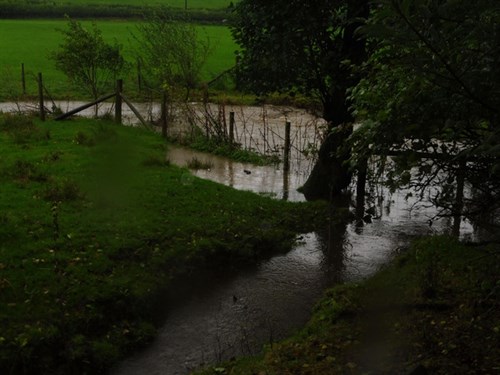
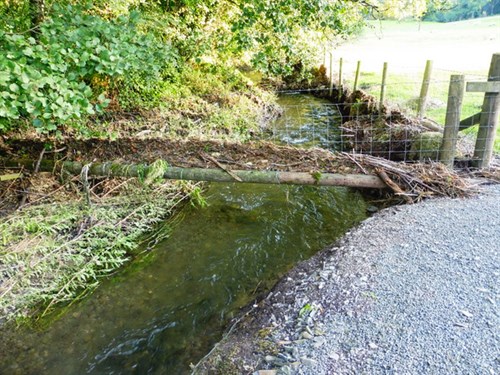
The winds flattened some large leaved plants like gunnera and
the later courgettes that were cropping so well.
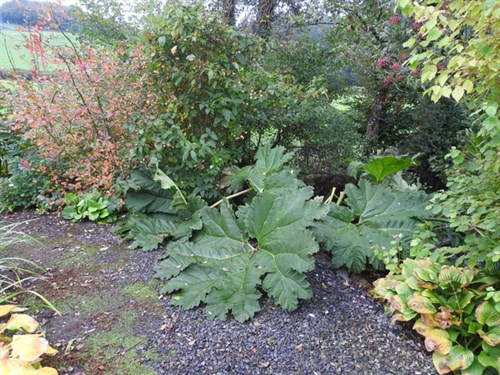
Even short growing plants like this colchicum " The
Giant" (at 4" not that big) like many others in the garden
were falttened.

One good side was that they brought down many of the inacessible
apples on our tall Bramley trees, many of which fell onto the lawn
which broke the fall and gave us plenty of useable windfalls that
should keep for a good few weeks. Many of these found their way to
grateful friends and neighbours. There were a few pleasant
September like "golden days" with some warmth and lovely
sunsets.

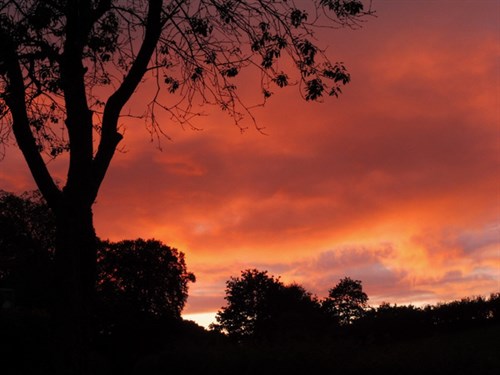
Towards the month end the nights got colder and on two occasions
we got perilously close to an air frost, but we just avoided some
serious plant damage which is always a problem when so many plants
are still in active growth, which often signals the coming to an
end of the full gardening year. With our respective health
conditions, the successfull flowering year has given us much
pleasure and sustenance.
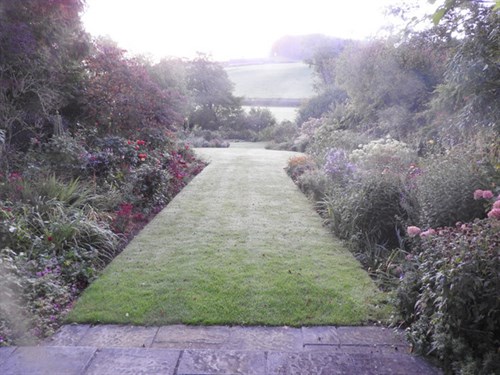

To get the pics of a frosty morning just for you, I got up
at 6.00a.m to capture the first hoar frost, and the soft pink
sunrise. Not a scene I am the familiar with!!
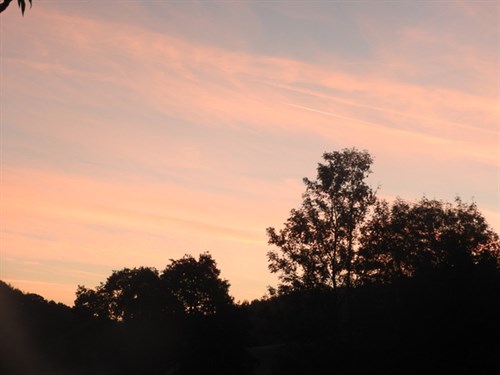
And at the other end of the day images of the
Harvest Moon
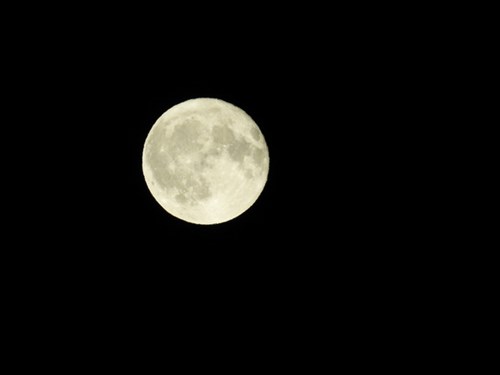
And the waxing moon with that lovely creamy
colour.

Garden update
Fabulous autumn tree and shrub colour from
cotinus "Grace", euonymus alatus and liquidamber, badly
disfigured almost a year ago by a searing gale
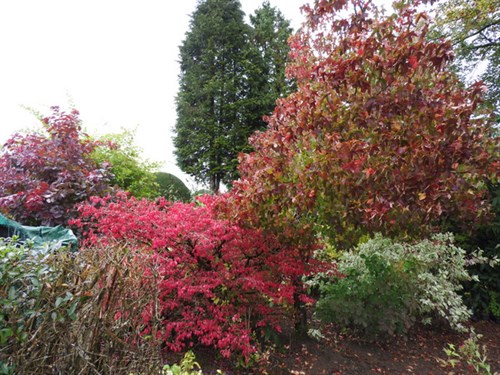
One of the best colouring and earliest is sorbus
"Olympic Flame" almost as good as any acer, and like most in the
genus good value from spring to autumn
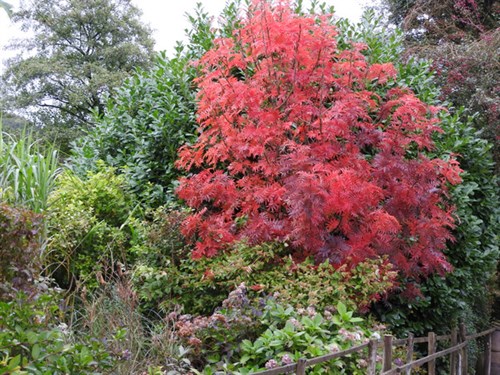
Because we have always tried to keep the gardening year going as
long as possible, we have planted many late season flowering
plants, which with those plants that have the capacity to keep on
flowering until the worst of the weather arrives, greatly
extends the flowering period. We used to open the garden for the
NGS until the end of September, and many visitors were fascinated
to see just how many plants you can have in flower throughout the
month or making a contribution in some other way, in all but the
least favourable weather. Some choices of the best plants to
achieve this can be found under this heading and the next one.
The lawns here always set off the garden in a good light so we
continue our 2 - 4 times a week mowing regime, and keeping the
edges tightly trimmed. As does keeping the hedges cut and the shape
of the large yew tree at the entrance to the Paddock garden
trimmed. Nothing like the topiary as seen in many larger gardens,
but a crisp outline is always pleasing to the eye across the wider
garden.
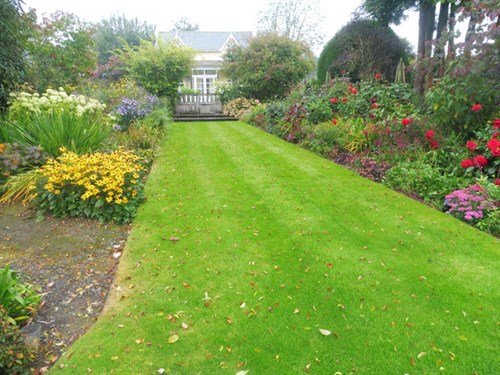
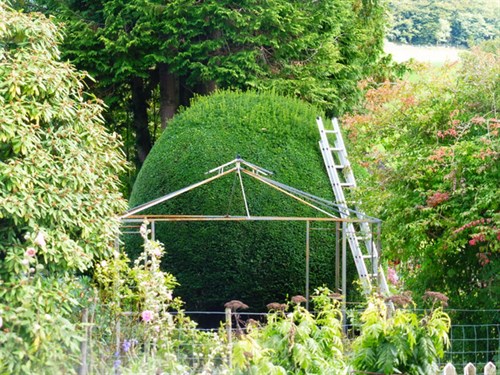
We had quite a challenge at the beginning of the month when
parts of the lawns started to show signs of damage caused by birds
pecking the turf to find the juicy morsels (cockchaffer
grubs) underneath. How do they know they are there? In some years I
have been known to peel back the worst affected areas of grass,
leaving them open so the birds can attack the grubs and then
re- sow grass seed which just has enough time to become eatblished
before the arrival of early winter. This year however for the first
time I used "Nemasys" nematodes treatment which is readily
available on line and easy to apply with a watering can. It is much
less work than removing the turf and apears to have been very
effective. I will still need to surface sow grass seed and top
dress with sharp sand or top soil. Feeding the lawns with a
speciality winter feed once or at most twice during the winter is
always a good policy to keep the lawns looking surprisingly
green.
Vegetables have continued to crop well with courgettes to the
fore and runner beans at last cropping well, but rather small.
Repeat sowing of these and late salad leaves ensures
continuity of supply for another month or so.
Mixed seeds of coloured carrots have produced the best
and tastiest of all the 4 varieties we have grown this year, each
of the 4 varieties orange, black purple, red and creamy yellow a
different flavour. Quite a sight on the dinner plate.
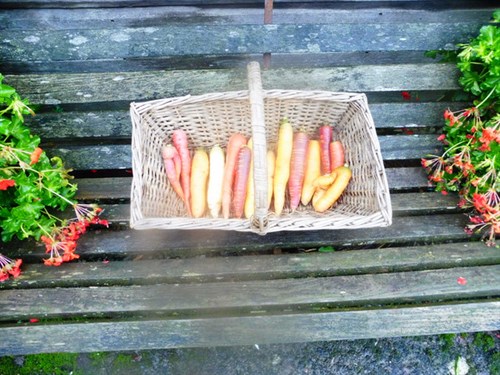
This is the time of year when root crops start to come into
their own as their flavour matures, with some good parsnips,
carrots, beetroots and celeriac, providing a different taste
at the meal table.
A huge parsnip, celeriac and a caterpillar damaged
cabbage which not surprisingly was not very good.
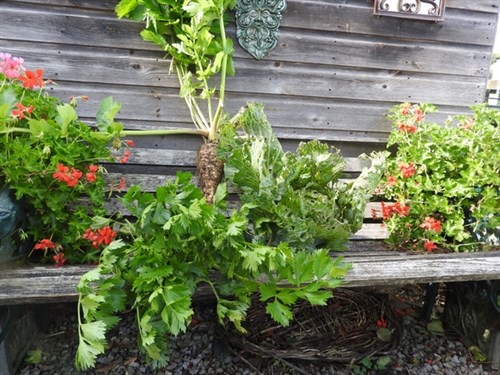
Sadly all our sweetcorn came to a premature end
before the month began, but I found a picture I hoped to publish in
last month's News, of what I think is an unusual take on a ripe cob
of the tasty vegetable. Quite artistic if I can be so bold to
suggest!!

Help is always useful in the garden and Kit Kat takes an
interest in what I am doing. He got the wrong idea when the
basket came out to gather the apple crop. He took a different view
and wasn't slow to let me know!!
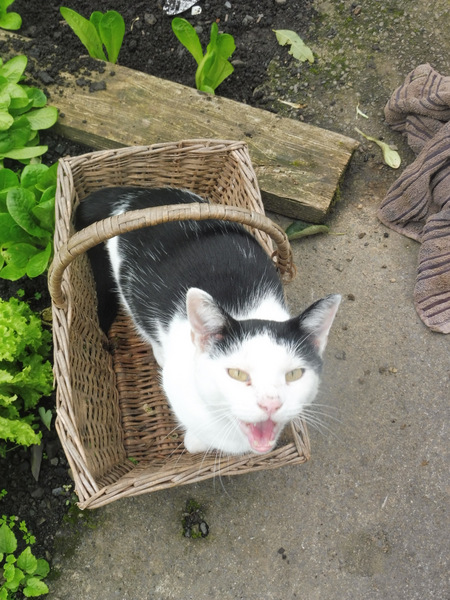
With the cabbage tribe still troubled with caterpillars we are
short of them but recently I did manage to purchase from a
local garden centre, some nice plants of an early season cabbage,
Hispi, which, being quick to produce an early crop, should with
luck.produce some fresh tasting spring cabbage in 4 - 6 weeks.
A scary picture, caterpillars on a kale plant looking
like the head of Medusa! None of the true leaves were
left.
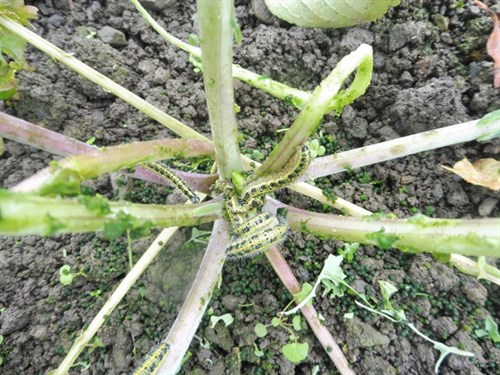
The star prize for the best croppers in the garden goes to the 2
Bramley apple trees. which in the 42 years we have been here
haven't cost us a penny! We just let them get on with things. They
don't always crop well but this year they have gone absolutely
bonkers. They are not easy to pick as this variety is a tip bearer
which on such large trees, makes it difficult to to harvest the
fruit.
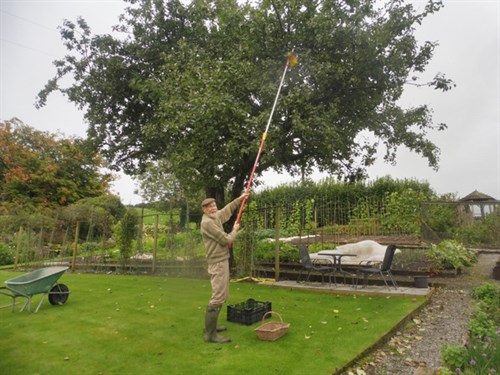
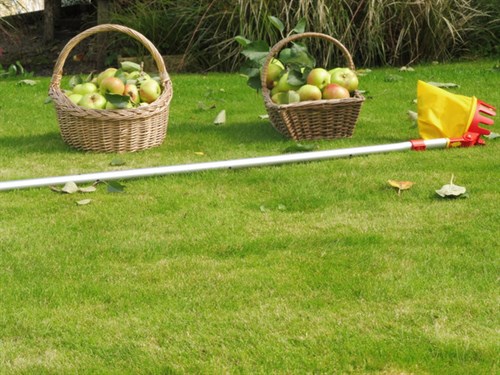
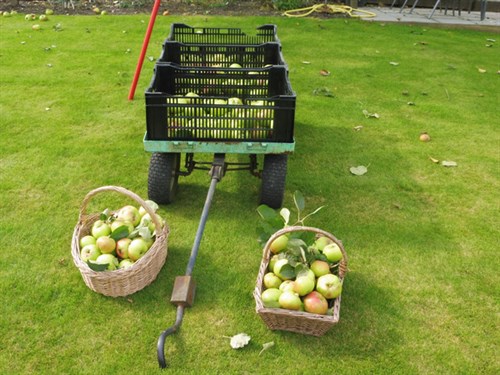

On top of all this I managed to find time to clear the Paddock
Pond for one last time before winter sets in. At last I found the
reason for the blockage of the inlet from the stream which keeps it
topped up:- it was an almost round pebble at 4" exactly the same
size as the inlet pipe! Somehow with vigorous rodding I removed
it.
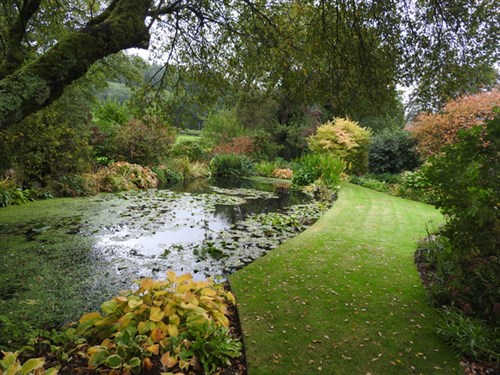
On the ornamental plant front, many are still making a
contribution to the borders.
In the Paddock Garden shade border in perfect
harmony remaining flower heads on hydrangea aspera ssp.
sargentiana, in the foreground rudbeckia sullivantii "Goldsturm"
still going strong and at the back Kirengeshoma palmata, a tall
herbaceous member of the hydrangea family up to 5-6 feet
tall

Pink flowers are everywhere at this time of year on a
wide variety of plants, this pic highlighting chelone obliqua a
border stalwart for at least a couple of months to the end of
October, together with asters (symphyotrichum) and a late flush of
astrantia
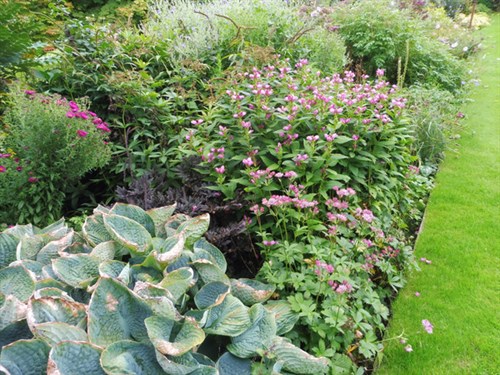
Burning red colour from sorbus and massed berries on a
native hawthorn- a marvellous year for berries of all
sorts
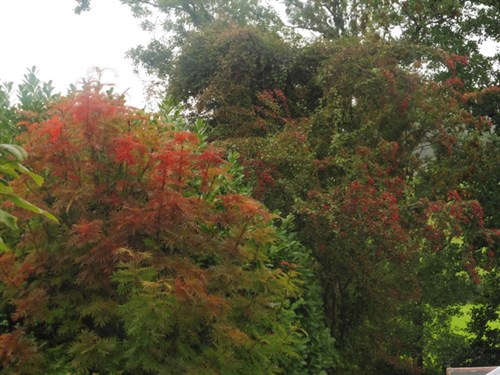
Miscanthus add real substance and movement to this
border complemented by fading hydrangeas
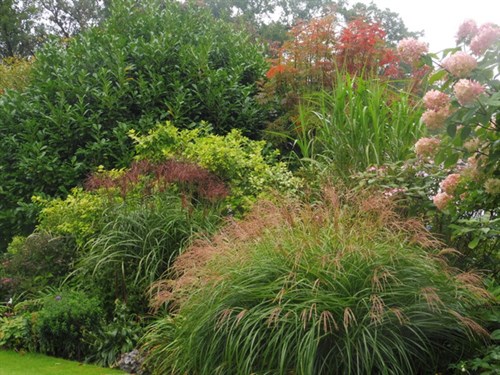
In terms of garden design, in a busy colourful garden,
it is often recommended that open green spaces are left to provide
contrast to the activity going on all around. I can't say that this
was my main purpose in creating the space in the Paddock Garden
where a former Veg bed was once sited. I do think though it has
made a terrfic impact! He said modestly!!
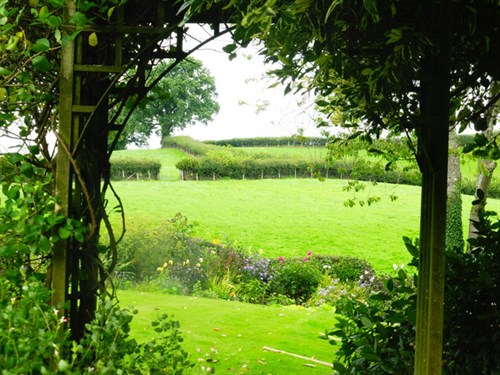
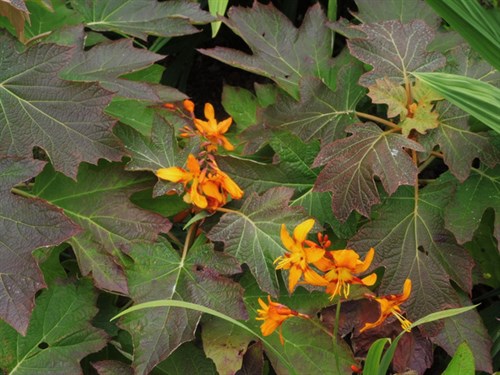
The beech hedge walk where all the winter and
spring activity takes place particularly our hellebore collection
which was looking very sorry for itself in high summer but there is
still interest with a wide planting of cyclamen hederifolium which
this year was month later than usual, but when the rains came they
simply took off!
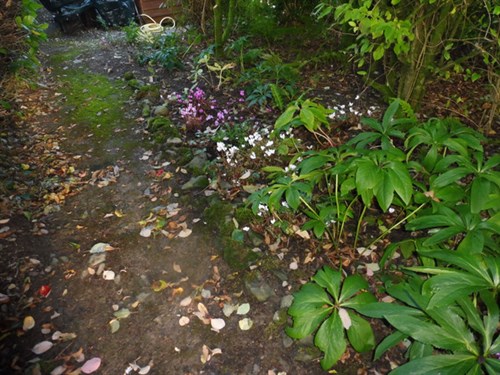
It took me quite a while to get used to orange in a
border now we have several borders which feature
them

Most pleasingly roses, after a disappointing spring / early
summer flush. Having been repeatedly dead headed by Moira and fed
with rose food at the end of june what a difference it has
made..

Rosa " Munstead Wood" one of my all time favourites, not
only because of its connection with Gertrude Jekyl, but also
because we are friends of the current owner of the property which
has been a special privilege for us.
This one is for you Marjorie!

Many other fine plants deserving pride of place are highlighted
below under the next heading.
Hardy begonias are becoming increasingly popular
particularly B. grandisna evansiana of which there is a wide range
of cultivars and sports. Alongside is that wonderful Japanese
woodland grass hakonechloa macra in part shade.
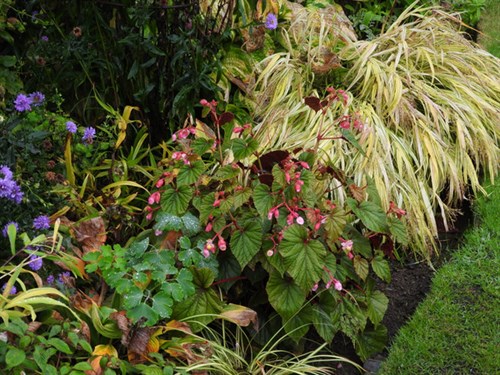
What's looking good?
Aster divaricatus a long flowering shade
lover.

Pink aster (symphiotrichum) "Anita Webb" with astrantia
"Ruby Star"
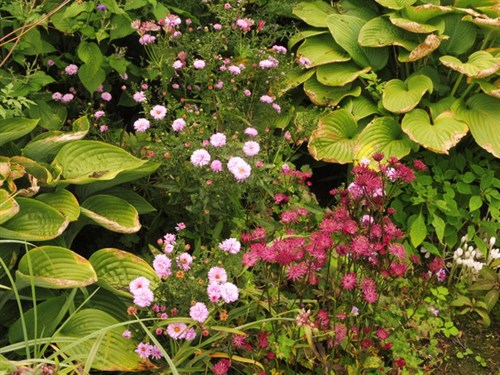
Hydrangea "Preziosa" should have a common name of the
"chameleon plant" because of the number of colour changes the
flowers go through which extends also to the leaves in
autumn.
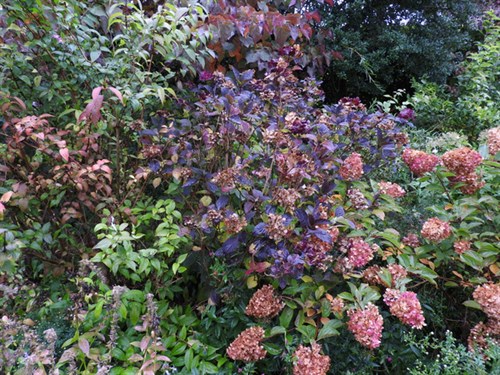
Colchicum "Waterlily"
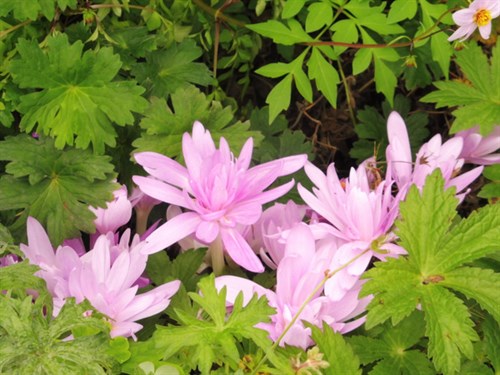
Liriope muscari "Royal Purple" which like most of the
genus grows happily in part shade in slightly moist conditions and
flowers into late autumn, sometimes producing late black
berries

Like many " Hardy Planters" I have always been keen on
hardy geraniums but you can't collect all of them in a huge
genus, and earlier this year Margaret, a gardening friend of ours
recommended g. himalayense "Derrick Cook" for it's large flowers
and pale blue flowers with a darker blue veining" and it is indeed
a fine plant which spreads controlably. such a "good
doer"
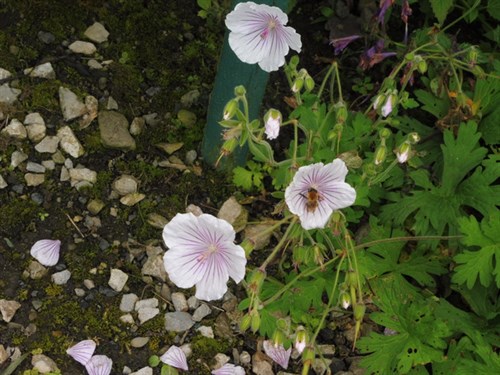
In the foreground of this pic at a friend's
wholesale nursery is a fine stand of geranium "Rozanne" Probably
one of the most admired in the genus
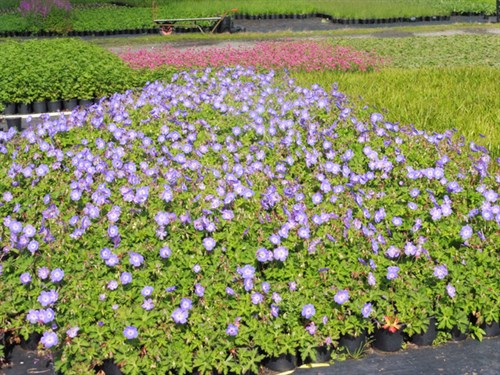
Selinum walichianum an excellent later flowering
umbelifer to 5 feet for moist but not wet soil in part shade
or sun. Look at those lovely purple stems.
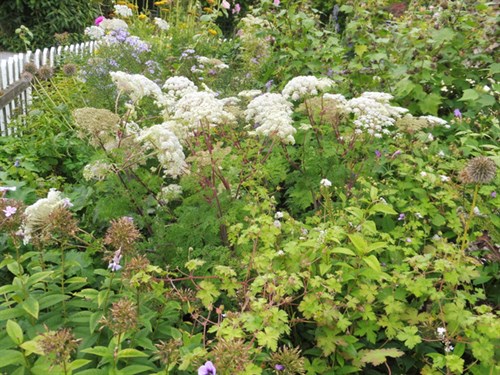
Blue spires of aconitum carmichaelii and in the
background helianthus "Lemon Queen"
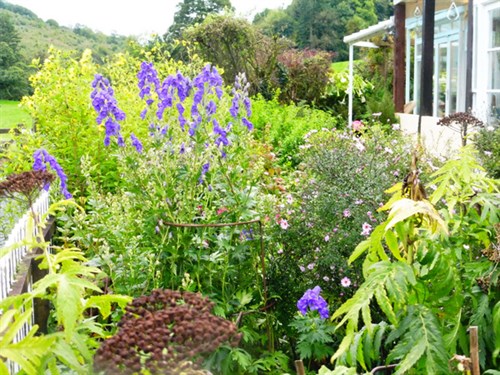
Clematis rehderiana, slightly scented hence its other
name of the cowslip clematis.

Berries on viburnum opulus and if you can see them
on this rainy day, a few blue flowers of Clematis alpina, normally
a spring flowering clamatis which sometimes has later
flush
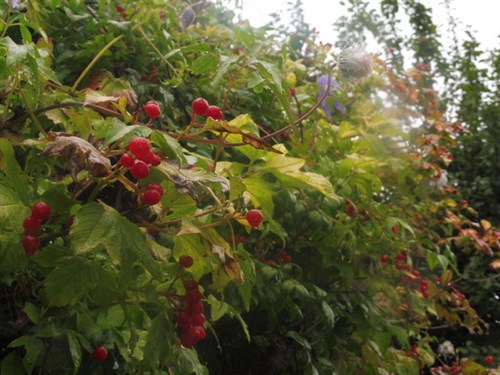
Everywhere you look in the garden there are plants
looking like they are on fire. Here sorbus "Olympic Flame" set
aside a self seeded native hawthorn covered in
berries.

One of the few plants that seem later than usual is the
hardy fuchsia, but it was good to see one of my favourites "Lady
Bacon" coming into bloom in mid month.

A relatively hardy bromeliad Fascicularia bicolour
which looks like it is on fire, cooled by those waxy blue
flowers
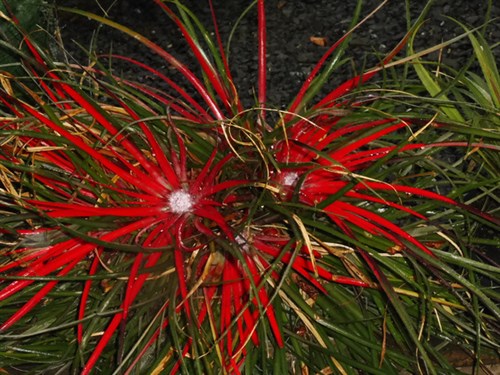
When we went to Kilver Court in Somerset last
month the garden shop had a number of streptocarpus in a sale. None
of them had labels, but a sucker for a streptocarpus and a bargain,
it didn't concern me there were no plant labels and I am now glad
that I made the purchase. Two unusual forms below yet to be tracked
down, but possibly Dutch or Belgium in origin.


Astilbe "Beauty of Ernst" joining in the fire
fest.
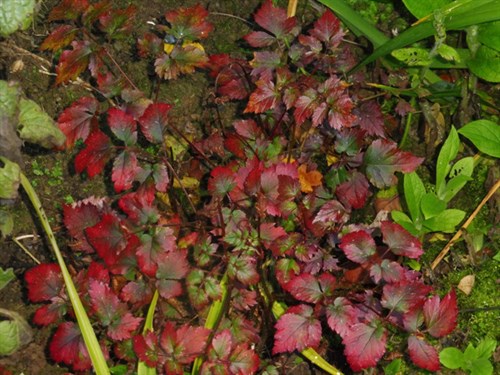
Salvia "Amistad" in a lovely shade of deepest blue, one
of several in the gardens reflecting our love of this
form.
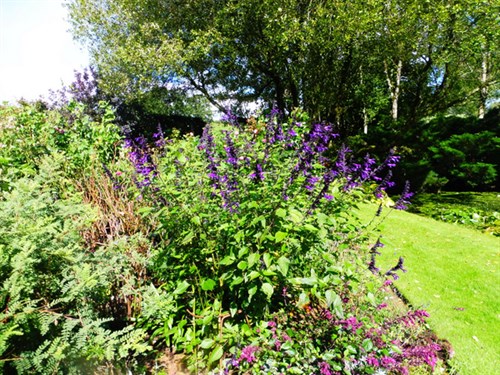
Salvia confertiflora in the Red Border making an
impact at nearly 5 feet tall
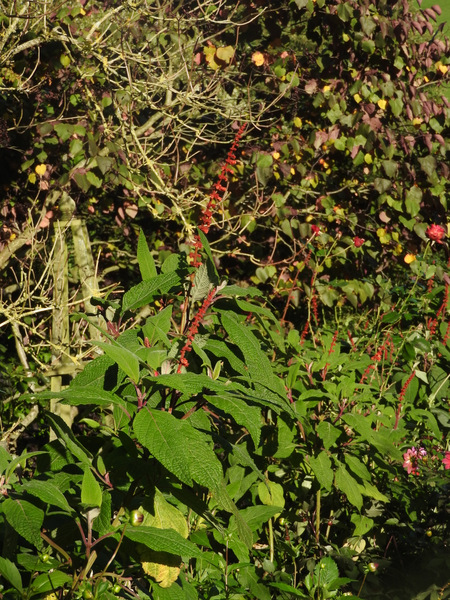
Salvia "Waterperry"
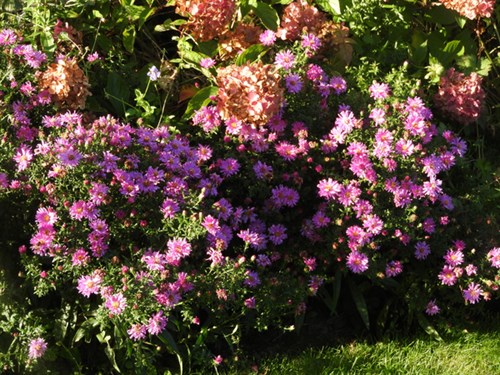
Miscanthus gracillimus on left and "Adagio" on the
right, the two contrasting well with each other
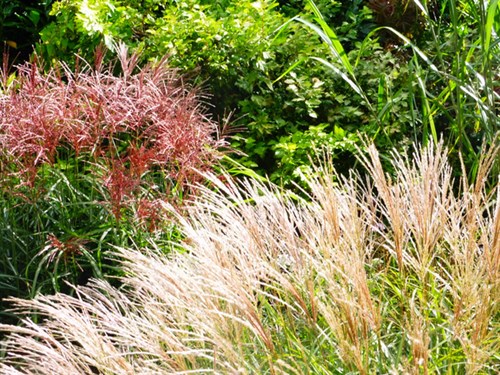
Dahlia honka yellow. Good open flowers like this are
always attractive to bees
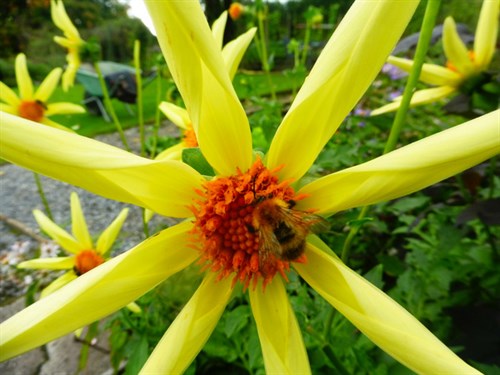
This shiny clean rose is of Fench origin from Delbard
roses The variety is "La Rose de Molinard". There are a few
roses in this group and in my experience they rarely have fungal
and viral diseases unlike many other roses we have in our 100 or so
in the garden from other rose nurseries.
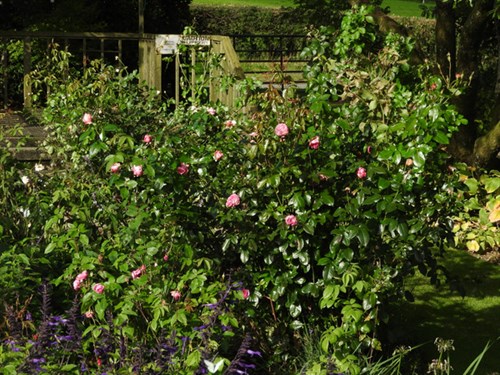
Ageratum petiolatum, a rare and unusual form as it
is perennial and possibly hardy. I have not tried that out
yet.
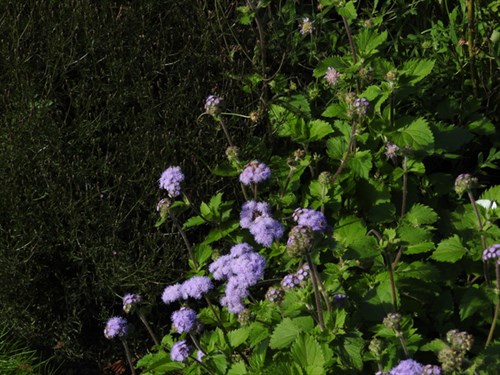
Sorbus rosea a good all round tree for a smaller
garden with flowers, berries and great autumn colour in many
varieties.
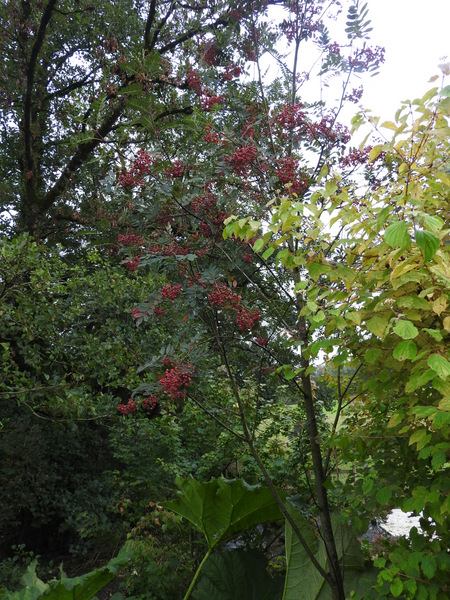
Sorbus have done well in the garden here over the years,
the climate and soil conditions suit them well. Although there are
only 7 of them they make an excellent impact. All of them came
from, Hergest Croft, a favourite garden of ours in Herefordshire,
with a National Plant collection.
An autumn bouquet with a difference for you dear
reader!
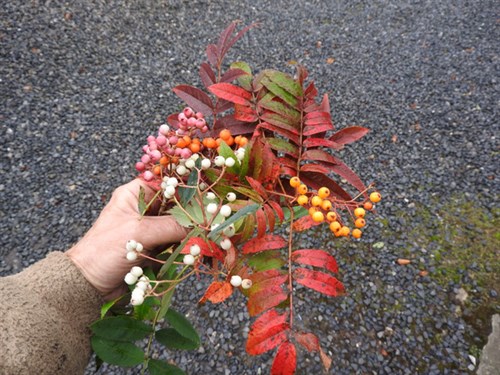
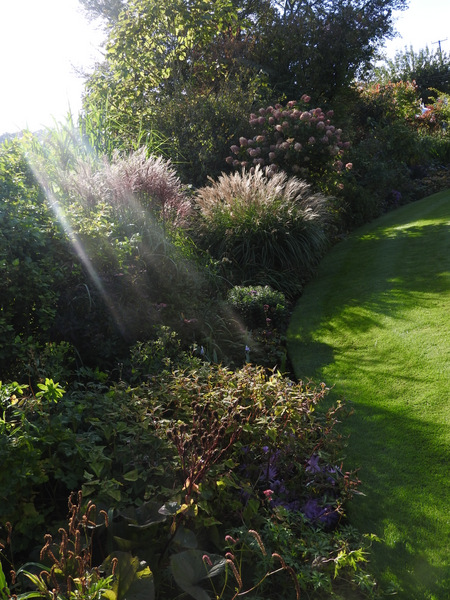
Rocoea "Cinnamon Stick" A genus wth a growing following
and a wider range of forms.
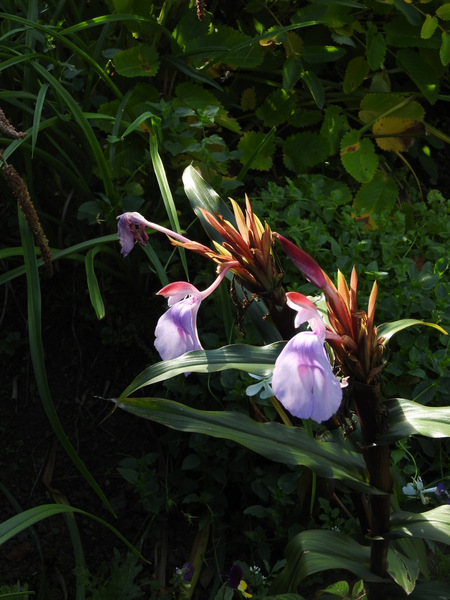
Wildlife and countryside
Swallows were very slow to arrive here in the Spring and once
they did they were not in the numbers you would normally expect to
see. With such fine weather and masses of flying insects to feed on
that seemed rather strange. Perhaps events overseas in countries
where they overwintered had an influence. Whatever it was the
swallows that were here didn't seem that keen to stay for long! So
it was that almost as soon as September arrived they began to form
flocks on the wing, and with none of the massing on telephone wires
that is normaly a prelude to their departure. Within a couple of
days they had all gone and the only ones we continued to see
afterwards were those travelling south from more northerly
locations. No picture opportunities therefore of one of the
wildlife events of early autumn.
We have however recently seen more butterflies than we have all
summer, with lots of perfect butterfly plants to feed on,
particularly sedums, asters and single dahlias, but nothing rare or
unusual.

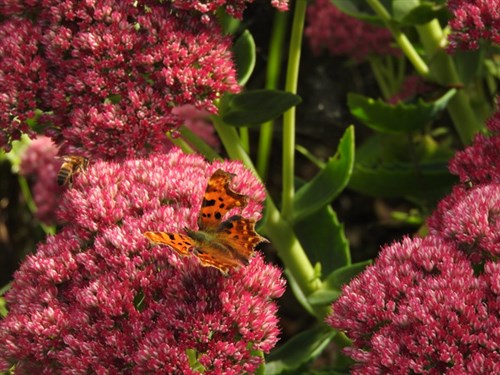
Events of a more usual autumn kind are in evidence in the
surrounding fields as breeding ewes are moved to their winter
quarters, and await the introduction of the rams - the
continuous farming cycle in this part of the world repeating
itself.
Neighbouring farmers are uncommonly active in getting in a late
harvest that the unprdictable weather over the last few
months put on hold. Some farmers are short of silage and hay
to get them through the winter, quite a concern with some long term
forecasts suggesing a cold and frosty winter.
An ash tree that last year I woried for because it had clear
signs of ash dieback disease but this year it has grown
strongly and is now dripping with ash keys. Only time will tell if
it will survive another year. I have a close affection for it as I
planted it as a sapling dug up from the forest drive which was due
to be levelled in anticipation of a programme of re-
aforestation.
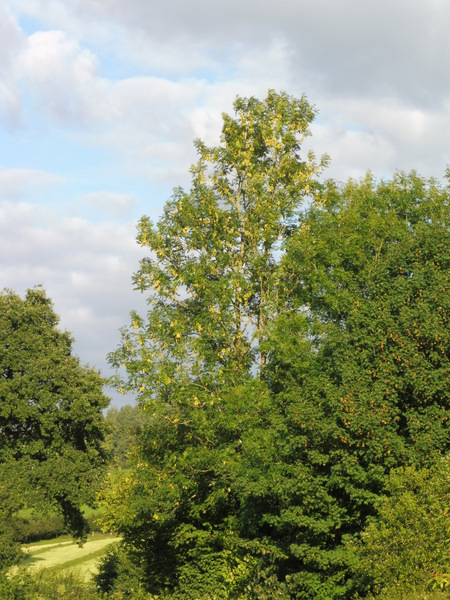
Naturalised non-native plants like Himalayan balsam and Japanese
knotweed are in their prime at this time of year in the moist and
shady conditions that suit them best all across this part of the
world. Whilst acknowledging the problems they can cause to
indiginous plants and local environments, the plantsman that
introduced them many years ago certainly had a good eye for a plant
as, at their mature best, the certainly can put on a spectacular
show in a big landscape.


Just a week ago we had a very early visit from our first
otter(s) of the season to the Paddock Pond, the game being given
away by upturned waterlilies, pond weed and fish scales on the
bank. They normally come in later autumn with young otters looking
to establish territories of their own. It will be time soon to get
the electric fence in place to humanely deter them, but a short zap
on a wet nose certainly deters them for most of the winter.
Two days after the attack there were fish showing on a
sunny day and large shoals of fry from this years spawning of
rudd.

Visits
Just one garden visit to report on, to friends Matthew and Tim
of Nantyietau , St Clears , Carmarthenshire SA33 4HF, who for the
first time opened their garden for the NGS this summer and hope to
do so again in 2019. I have commented upon this fascinating garden
in the 25/7/18 News edition entitled "June was busting out
all over" but unfortunately as has been the case recently on
the website, I was not able to publish pictures. This time I hope I
will be more successful because words cannot fully describe what an
amazing plantsman and wildlife lovers garden it is. Keep your eyes
open in February for for the publication of the 2019 National
Gardens Scheme Yellow Book and Western Counties Booklet,
featuring amongst other counties, Carmarthenshire. Make the most of
the opportunity to visit a fine new addition to some of the many
fine gardens in what is becoming, along with Pembrokeshire, a
gardens hotspot.
There are several outbuildings which have been cleverly
adapted to accommodate a wide range of tender and tropical plants,
many of them unusual or rare. There are also other buildings for
tropical butterflies and moths, Huge Koi carp, and other intruders
like quail and other native birds. And outside, poultry and a
collection of peacocks. Totally fascinating!

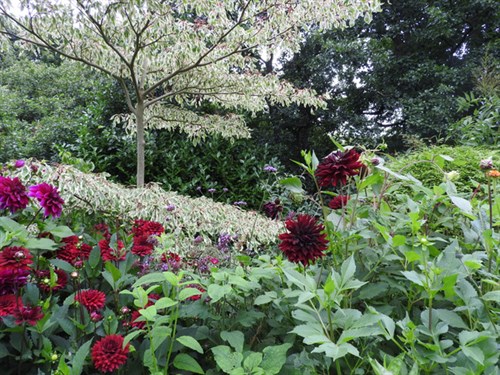
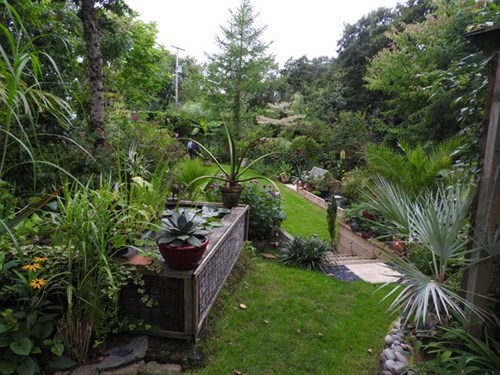
I felt sure I have come across this salvia before
in a delightful shade of blue but have not yet been able to
identify it, there are plants like this all over the
garden


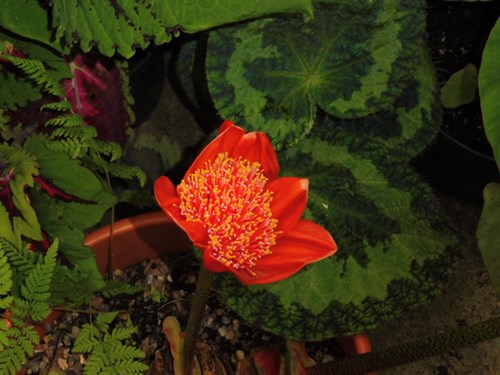


And an another outbuilding, an unexpected encounter with
an American snapping turtle, as viscous as it sounds and another
from china.
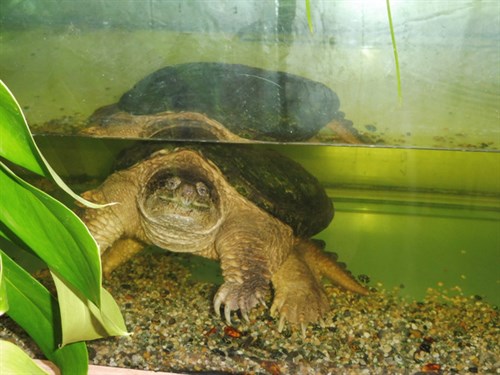
And finally a visit of a different nature came at the beginning
of the month. The Tour of Britain Cycle Race passed within 1 mile
of Cilgwyn Lodge. What a treat to have a national sporting event
come so close and along with almost all the residents on our
lane,it provided a good opportunity to meet up and share the event
and the camaraderie that exists between some of the best neighbours
you could wish for.




Thanks for staying with this exceptionally long News
Letter. There was plenty to report on and I feel that I got
rather carried away with the fact that I was at last able to
download all the pictures that I wanted to share with you. Enjoy
the rest of what has been an exceptional gardening year.
Keith and Moira X